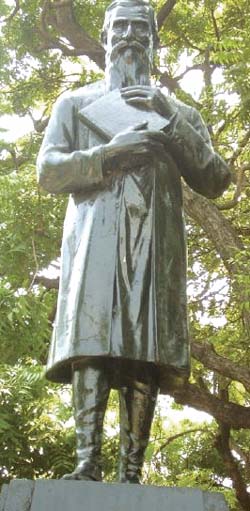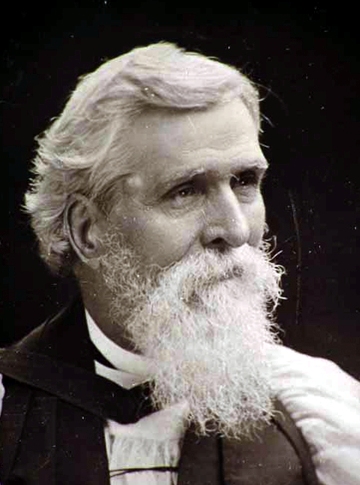 An edited
extract from Robert Caldwell: A scholar-missionary in
colonial South India by Y. Vincent Kumaradoss (ISPCK,
2007). www.ispck.org.in
An edited
extract from Robert Caldwell: A scholar-missionary in
colonial South India by Y. Vincent Kumaradoss (ISPCK,
2007). www.ispck.org.in
Church Times, 26 October 2007
Robert Caldwell was revered by his
people - but a victim of party spirit, Vincent
Kumaradoss says in a new biography.
Caldwell was soon beset with a series of
problems that began to hamper his work. His tenure as
Bishop was the most trying period of his time in
Tirunelveli. It was tragic that so outstanding a career as
Caldwell's should have been blighted at the end by his
rupture with the Society for the Propagation of the
Gospel's (SPG's) Madras Diocesan Committee (MDC).
Feeling his age, he was not physically the
same person he had been, and he complained of his health
often. The theme of weariness began to recur constantly in
his correspondence. He was now, despite this, a man in a
hurry. Even though he had not been keeping good health, and
a hostile campaign was launched against him and his wife,
Eliza, he was driven by his sense of duty. The routine
continued, in spite of illness, and in spite of setbacks
and disappointments. The missionary task of evangelism
proceeded as Caldwell stood his ground.
It is difficult to avoid the impression
that the conflict arose to a considerable extent because
the MDC seemed deliberately to assert itself in order to
provoke and frustrate the new Assistant Bishop. A careful
reading of the records makes it almost impossible to argue
that Caldwell was not the entirely innocent victim of
almost unrelieved malice on the part of the MDC throughout
his episcopate.
Gratefully remembered: a bronze statue of
Bishop Caldwell erected in 1968 on the Marina beach,
Chennai. There it is one of eight statues of distinguished
Tamil scholars commissioned by the organisation Dravida
Munnetra Kazhagam. Caldwell is described as "the pioneer
Dravadian linguist" His own occasional references to
"party" indicate the main source of this, and that his
opponents brought to the issues between him and them the
often virulent internal disputes of the Church of England
in England at that time. This was something that the SPG's
foundation documents, back at the beginning of the 18th
century, had required its members to eschew, and at its
best successfully. But the Society and its members were not
always at their best, the later decades of the 19th century
being a case in point. 'The bier was met by a crowd with
"all the marks of loyalty and love" '
The reason for the antipathy shown to him
by the MDC in his last years, by comparison with earlier
times, is difficult to assess. Much of it must be due to
the calibre and experience of the men who by chance then
composed the committee, and the influence of their
secretary. Clearly, there was between them a lack of
understanding of the situation of SPG missionaries and the
native Church far away in the field.
To add to these shortcomings, there may
have been some jealousy over Caldwell's high reputation and
influence in England, and the financial support he
attracted direct from there, much of it going into Eliza's
schools.
Tension on ideological grounds had been exacerbated after
Caldwell was appointed Assistant Bishop, as the MDC was
coming to be dominated by people sympathetic to the Oxford
Movement. When they learned that Caldwell was, as they saw
it, an Evangelical, they began to look down on him.
He decided on a course to put the MDC in
its place. His immediate task was to restore his prestige
and inspire respect for the sacred office of bishop. Faced
with a chain of unpleasant events, the struggle was to
consume much of his time.
Gothic in India: the newly refurbished bungalow for the
pastor and its attached chapel at Idaiyangudi today - an
enhancement of the single room, 17 by 11 feet, that
Caldwell occupied on his arrival in 1841
Caldwell felt strongly the need to discontinue the MDC's
connection with the mission. While making his appeal in
England at this time, and expressing his hope of returning
to Tirunelveli with a fresh mandate in a fresh atmosphere,
he seized the opportunity to add a personal, almost
pleading note on his declining health:
"Though my health is only partially
restored, I should be delighted to return again to a field
of labour I love so well, if I could do so with advantage.
It would give me the greatest possible pleasure to devote
the last days of my life to the work of reorganising the
Tinnevelly Church and Mission on the lines I have
indicated, with the Society's approval; but I hope I may,
without impropriety, be permitted to say that, at my
advanced period of my life, with my nervous and sensitive
constitution, I should not feel myself justified in
returning to India to be placed in the same trying position
as before, and to encounter again those troubles and
worries which brought on the illness from which I have
suffered for the last two or three years."
In response to his suggestion, a resolution
was passed by the standing committee on 14 February 1884,
which ran as follows: "Agreed that the Bishop of Madras and
the Madras Diocesan Committee be requested to favour the
Standing Committee with an expression of their opinion upon
Bishop Caldwell's statement: it being prima facie the
opinion of the Standing Committee that there are no
insurmountable objections to the separate administration of
the Diocese of Tinnevelly." The committee in Madras,
however, took a different view.
In its detailed minute of 30 May 1884, the
MDC concluded that Caldwell's proposal was inexpedient and
impractical at that time. That only 12 years later, in
1896, it was possible for Tirunelveli to become, by
contemporary standards, a properly constituted Anglican
diocese is a measure of the reactionary, negative, and
misguided character of the opposition Caldwell faced, and a
measure, too, of the soundness of his own vision and
aspirations.
THE MDC was desperate to stall anything that would diminish
its domination. A long list of "animadversions" against
Caldwell was addressed to the SPG in London. The whole
exercise was clearly designed to present Caldwell as the
disrupter of peace in Tirunelveli, and to discredit him in
the eyes of the SPG in England, where, in fact, he was
respected and had considerable influence.
The MDC pursued its game with undiminished
vigour, intent now on crippling the progress of Caldwell
College. Pleading financial constraints, they drastically
cut the grant to the college.
In order finally to snuff out the college's
existence, three reasons were advanced. First and foremost
was that the SPG could not afford to maintain the college
due to its own financial crisis. Second, the results of
examinations were unsatisfactory. Third, the number of
students who attended the college was small.
Whatever might have been the truth behind these claims, it
was clear that the MDC was unwilling to see the institution
survive. The MDC closed the college section in 1894 and
reduced it to the level of a high school.
THE MDC had already characterised Eliza as
having an undue influence over the decisions of the ailing
Caldwell. Given its hostility towards Eliza, the MDC now
turned its attention to her pet project, the Girls Normal
School at Tuticorin, where a "large, beautiful and
substantial building", erected over two full years,
"through the indefatigable exertions" of Bishop Caldwell
and Eliza, had been opened by the Metropolitan of
India.
The School came under the scrutiny of the
committee when, in order to reduce its long-term financial
commitments, the MDC refused to take any responsibility for
new schools that had not been sanctioned by it. The MDC
questioned the legitimacy of this "Female Training
College", as the sanction of the committee had not been
sought.
According to the MDC, this was done in
contravention of the rules of the SPG, and it wrote to
Caldwell asking for an explanation. Caldwell argued that
they had not ignored the rules of the SPG, as the school in
question was not a new institution at all - it was, in
fact, merely the "Tinnevelly portion" of the "S.P.G. Female
Normal School" established in Trichy by his daughter
Isabella Wyatt, and now transferred to Tuticorin.
This step was taken because of the
practical difficulty involved in sending the girls to
Trichy. The MDC, bent upon frustrating Caldwell and Eliza's
efforts, passed a resolution that it was unable to
recognise the institution or undertake its future
expenditure.
The resolution came as a rude shock to
Eliza. Surprised and upset, she retorted that "it was quite
gratuitous on their part to pass such an unfeeling and
uncalled for Resolution." For Eliza, it was an insult
heaped on her for "life-long voluntary labours of forty
three years in the cause of female education", and a
deliberate measure intended to subvert the "crowning
effort" of her educational career.
The secretary of the MDC simply reiterated
the committee's stand that it was not possible to accept
responsibility for the school at Tuticorin. He argued that
a large sum of money from home was entrusted to the MDC
chiefly for the extension of "Christ's Church", and was
"only partially indeed to be spent in old Missions and in
the training and helping forward in life of the children
and grandchildren of Christians".
Eliza issued an appeal for money to
establish more girls' schools, and a female training
college for teachers, at Tuticorin. The appeal contained a
history of her 44 years of work in Tirunelveli in the cause
of female education.
Despite her attempts to get grants to keep
the institution going, the school had to give up the
training section in 1893. In 1894, however, after her
husband's death, while the training institution was shifted
to Nazareth, the school was upgraded as a high school.
AFTER 1888, Caldwell's "powers were slowly
ebbing out". Yearning for a cooler climate, he frequented
Kodaikanal, which was congenial to his health. He began to
spend much of his time there, and managed the affairs of
his office, shuttling between Kodaikanal and Tuticorin. He
began to suffer from physical exhaustion.
In July 1890, he requested the Bishop of
Madras to relieve him of miscellaneous work connected with
his district, so that he could continue purely with the
episcopal part of his work, such as confirmations and
ordinations.
Seeking a retirement allowance, Caldwell
wrote: "In taking this step, however, I feel under the
necessity of stating that I can only do so on the condition
that the Society will continue to [pay] me my present
stipend for the remaining years of my life. In my old age I
naturally require comfort and attention which as a younger
man I could dispense with."
The standing committee took strong
exception, and pronounced its displeasure over his seeking
to fix his retirement allowance as a "condition", and
disallowed his pension claim. The Bishop of Madras
solicited Tucker, the secretary of the SPG in London, for
release of pension as per Caldwell's wish. The SPG finally
released the pension on his terms in January 1891.
During his last visit to Tuticorin in
January 1891, he wrote a letter to Bishop Gell, resigning
his office from 31 January 1891. The very next day, along
with his family, he embarked on his last journey to
Kodaikanal.
THE STRAIN of a continuously busy life, the
hot climate of Tirunelveli, and the prolonged and
persistent attempt to derail his initiatives during the
later period of his bishopric had exacted a toll upon
Caldwell's frail body. In feeble health and beyond
recuperation, he spent the next seven months at Roslyn, his
bungalow in Kodaikanal, a hill station in the Nilgiris.
On Wednesday 19 August 1891, while
returning from his usual walk, he contracted a chill. The
following day, medical attention was sought. He was
confined to his room, where, undisturbed, he pulled through
for the next three days.
On Monday, he took a short stroll with
Eliza, but in the evening he was seized with fever. He
slowly slipped into a coma on the Thursday night. Though he
revived on seeing his son, Dr Addington Caldwell, who came
to see him from Australia, his condition was fast
deteriorating. He slowly slipped into a coma on the
Thursday night.
Next morning, at 9 a.m. on 28 August 1891,
Eliza and his children watched as Caldwell entered into
eternal rest at the age of 77.
The coffin carrying his body, dressed in
his episcopal robes, was conveyed down from the hills, a
journey of some 200 miles, by way of Palayamkottai, to
Idaiyangudi, to be with the people among whom he had
laboured for half a century. At Palayamkottai, a solemn and
impressive service was held on the Sunday, honoured by the
presence of "a large crowd of natives" and several
missionaries and Indian clergy.
The final journey from Palayamkottai
culminated on Tuesday morning, 1 September 1891, at 7 a.m
at Idaiyangudi, where the bier was met by a large crowd
with "all the marks of loyalty and love". After the funeral
service, the mortal remains of Robert Caldwell found an
appropriate resting-place below the altar of Holy Trinity,
the church that had been built by his own exertions, and
consecrated by him.
Heart-rending sobs and praise filled the
air as crowds of Christians, Hindus, and Muslims thronged
to have a last glimpse of the revered face, and to pay
their last homage to the priest and bishop who had for so
long been their "father and friend".
As his body came to rest in the mother
church of Tirunelveli, in many ways one of Bishop Robert
Caldwell's cherished desires had perhaps been fulfilled.
During his last visit to England in 1883, his parting words
at a special service held in the SPG's chapel, just before
his return to India, had been: "For Tinnevelly I have
lived, and for Tinnevelly I am prepared to die."
The Caldwell saga remained to be assessed
and justly honoured.
|



 Bishop Robert Caldwell (1814
-1891) was an orientalist who pioneered the study
of the Dravidian languages with his influential
work Comparative Grammar of Dravidian Languages
(1856; revised edition 1875). Robert Caldwell was
born on May 7,1814 to Scottish parents. Initially
self-taught and deeply religious, young Caldwell
graduated from the university of Glasgow and was
fascinated by the comparative study of languages.
At 24, Caldwell arrived in Madras on January 8,
1838 as a missionary of the London Missionary
Society and later joined the Society for the
Propagation of the Gospel Mission (SPG). Caldwell
realised that he had to be proficient in Tamil to
preach to the masses and he began a systematic
study of the language.
Bishop Robert Caldwell (1814
-1891) was an orientalist who pioneered the study
of the Dravidian languages with his influential
work Comparative Grammar of Dravidian Languages
(1856; revised edition 1875). Robert Caldwell was
born on May 7,1814 to Scottish parents. Initially
self-taught and deeply religious, young Caldwell
graduated from the university of Glasgow and was
fascinated by the comparative study of languages.
At 24, Caldwell arrived in Madras on January 8,
1838 as a missionary of the London Missionary
Society and later joined the Society for the
Propagation of the Gospel Mission (SPG). Caldwell
realised that he had to be proficient in Tamil to
preach to the masses and he began a systematic
study of the language.